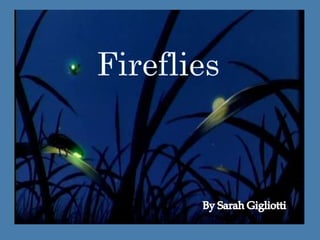
Firefly story
- 1. Fireflies Fireflies By Sarah Gigliotti
- 2. On a warm summer night, deep in the forest, a mother firefly is laying her eggs just underneath the cool ground. A few days after mating, in the late spring or early summer, a female lays her fertilized eggs on or just below the surface of the ground.
- 3. It can take 3 to 4 weeks for the eggs to hatch. Some kinds of larvae glow in the dark. This is a warning signal to predators since many firefly larvae contain chemicals that are distasteful or toxic. The glowworms stay in the warmth of their eggs for weeks and weeks until FINALLY they hatch from their eggs.
- 4. The newly hatched glowworms will spend the rest of the summer happily eating away in preparation for winter. After the larvae hatch from their eggs they will feed until the end of the summer.
- 5. When the cold and bitter winter comes, the glowwormsburrow deep in the ground until . . . Fireflies hibernate in winter during the larval stage. Some burrow underground, while others find places on or under the bark of trees.
- 6. The larvae emerge in the spring. After several weeks of feeding, they pupate for 1 to 2.5 weeks and then they emerge as adults. The larvae feed on small insects, terrestrial snails, and slugs. Some larvae have grooved mandibles, which deliver toxic digestive fluids directly into their prey before sucking out the liquefied body contents it’s spring! The glowworms are VERY hungry. They eat and eat and eat until they are nicely plump. Then . . .
- 8. In the early evening, these newly adult fireflies will go out into the night and light up the sky in hopes of finding their one true mate. The adult firefly's life span lasts only a few weeks, during which reproduction is their main goal.
- 9. More Facts on Fireflies There are 2,000 species of firefly found in temperature and tropical environments. Many fireflies live in marshes or in wet, wooded areas where their larvae have abundant sources of food. Fireflies tend to be brown and soft-bodied, often with the elytra more leathery than in other beetles. The most commonly known fireflies are nocturnal, though there are numerous species that are diurnal. The larvae are commonly called glowworms, not to be confused with the distinct beetle family Phengodidae or fly genus Arachnocampa. Light production in fireflies is due to a type of chemical reaction called bioluminescence. This process occurs in specialized light-emitting organs, usually on a firefly's lower abdomen. Fireflies emit light mostly to attract mates, although they also communicate for other reasons like to warn predators. Fireflies emit the most efficient lights in the world—100% of the energy is emitted as light.
